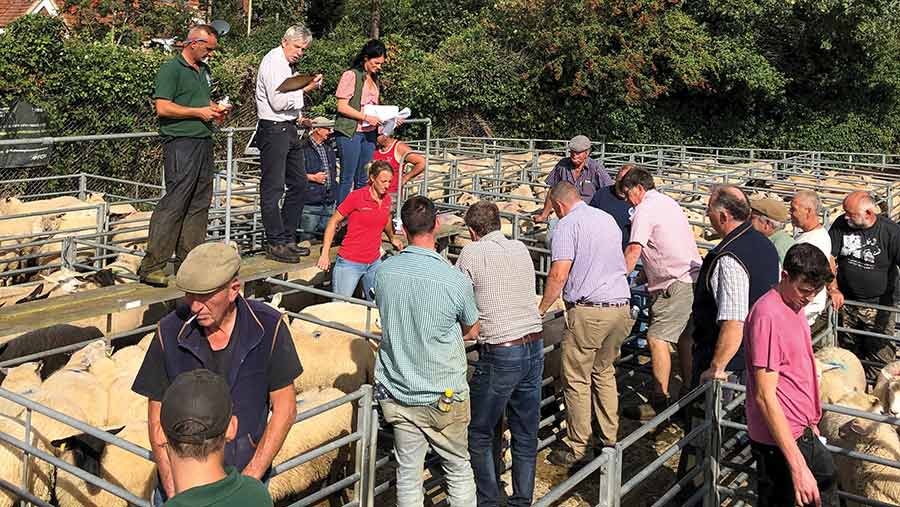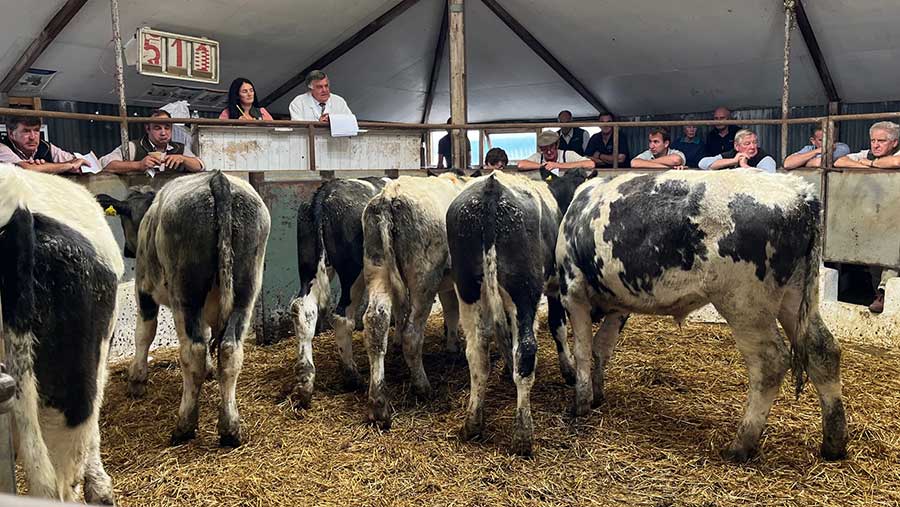More auctioneers needed for thriving livestock markets
 Sheep auctioneer Nick Young (in white shirt) at work at Hailsham market © MAG/Suzie Horne
Sheep auctioneer Nick Young (in white shirt) at work at Hailsham market © MAG/Suzie Horne Livestock auctioneers are in demand, with markets wanting committed, professional people.
Both the Livestock Auctioneers Association (LAA), representing market operators in England and Wales, and Scotland’s Institute of Auctioneers and Appraisers (IAAS) will support aspiring auctioneers to complete their formal training while also learning on the job.
This is through a course in Livestock Market Operations and Management, offered by Harper Adams University and run by Dr Michael Simcock.
See also: Consider becoming a skills training instructor to boost farm income
There are 30-40 students on the course at any one time, with an intake of about 10 a year.
Michael receives calls from employers looking for auctioneers. Successful completion of the course delivers membership of the respective bodies representing markets and auctioneers.
This is in addition to on-the-job training which can be undertaken by a wide range of candidates, from those who have recently left school but have some work experience in markets, to graduates in a suitable subject or a related qualification such as chartered surveying.
The course is a combination of tuition and coursework, with the LAA paying a substantial portion of this and the employer expected to contribute the remainder.
For the 2023 intake, the total fee over four years is £7,500.
The learning covers a wide range of the aspects of the job an auctioneer, fieldsperson and/or market manager might have to handle, including health and safety, welfare, supply chain issues, people management, tax, law and valuation.
Zanna Dennis is the LAA’s development officer. She also works part-time at Bentham Market and is attending the course to inform her LAA work.
“We want to encourage more people into the industry,” she says. “All roles at the market are essential; you’re working in a small team in a big business.”
Next generation
The LAA has a well-supported 70-strong next generation group, for members aged up to 40, which meets up to four times a year.
This offers members a forum in which to exchange ideas and experiences and sometimes to raise issues which they may not be comfortable discussing openly with senior management of the businesses they work for, says Zanna.
“It’s a good social and professional network, with lots of peer-to-peer learning.”
Some marts also offer an apprenticeship route to auctioneering – for example, Carlisle-based Harrison & Hetherington.
Skipton-based Craven Cattle Marts (CCM) and Craven College have joined with several local farmers to offer apprenticeships aimed initially at 16- to 18-year-olds under the general farm worker apprenticeship qualification.
This involves placements at Skipton Auction Mart to gain sale day experience, plus farm-based experience and day-release college training.
Launching the scheme earlier this year, CCM’s general manager and auctioneer, Jeremy Eaton, said: “It’s noticeable that with the requirement for students to stay in full-time education until the age of 18 that the traditional source of applicants for roles around livestock markets, particularly those who live on farms, has dried up.
The combination of CCM working alongside proactive farms means that a student can fully learn a variety of disciplines to become very employable in the rural sector.”
How does the LAA/IAAS course work?
Candidates must already be working in the industry and be supported by their employer.
The minimum age is 18 and students should have maths and English GCSEs at grade C or above, or have been employed in or undertaken work experience in the livestock sector.
Enrolment is in January, during an induction and tuition week at Harper Adams. Further study is supported online through to July, with a return to the university for further tuition, visits and assessment.
Students are encouraged to get together between campus visits to check out local markets and meat processors, and other related activities.
The first two years cover work towards the University Foundation Certificate, studying three modules each year. This achieves associate status with LAA/IAAS.
Students can then move to the Certificate of Higher Education, involving three more modules over two years, to gain fellow status.
All modules are graded Level 4 in the National Framework for Higher Education Qualifications, the equivalent to the first year of a degree course.
Graduates in certain subjects and holders of other suitable qualifications can cut short the route to the qualifications, but there is still a minimum study requirement.
Livestock market stats
Stock numbers sold through the 120 English and Welsh LAA marts in 2022 just topped the 2021 figure.
Compared with 2019 – the last full year before Covid-19 hit trade – mart throughputs last year saw an increase of more than 250,000 head. Turnover was up by £27.5m to just over £2.1bn.
2022 numbers – England and Wales
Cattle 1.02 million
Sheep 9.65 million
Pigs 97,000
Calves 242,000
Market challenges
A study by Exeter University’s social sciences department in 2020 identified the main challenges for auction marts as lower stock numbers being kept overall, more deadweight selling, business rates, TB control requirements and staffing.
It found that for some marts, attracting new auctioneers or auction managers who are right for the job was very difficult.
Many marts prefer to bring people in at a young age and train them to fit the market in question.
For those markets that were able to recruit auctioneers, time pressures sometimes hampered efficient training of new recruits.

Senior auctioneer Roger Waters at Hailsham market © MAG/Suzie Horne
Hailsham market opportunity for career auctioneer
Hailsham is a traditional charter market, dating back to 1252 and the only livestock market still operating in the geographically wide county of Sussex.
It holds weekly prime and cull stock sales on Wednesdays and, depending on the season, weekly or fortnightly store stock sales on Mondays.
Senior auctioneer and fieldsman Roger Waters is over 70 and has 50 years’ selling experience, while sheep auctioneer Nick Young is well into his 60s.
Both are fully committed to the market, but want to see it in the hands of a new auctioneer with some experience, who can take on much of the work.
This includes a busy off-site farm machinery and stock sales calendar of about 25 sales a year, including the annual Dolphin sheep fair.
“We’ll carry on, but it’s a wonderful opportunity for someone young and fit to come in and take the market on,” says Roger.
Hailsham has a loyal and enthusiastic farmer following, says Nick, who considers auctioneering a vocation.
The number of sheep producers in the area has grown in recent years, and continues to do so, bringing in new vendors.
The nearest alternative market is Ashford in Kent (46 miles to the east), then Salisbury in Wiltshire (108 miles west), and Thame in Oxfordshire, which is 116 miles distant.
As with all marts, the community and support aspects of Hailsham are important and intrinsic to the operation, with a Farming Community Network presence on site and a thriving market café.
There is a planning application to take the market out of its town centre location to a greenfield site west of the town.
This will be heard late this year but the market will remain in place at its current location until permission on a new site is secured, says site owner David White.
There is a contract to sell the current site for development, but this is conditional on both the new market site and the current site gaining planning consent.
Once this is in place, the market will have two years in which to construct its new home.
